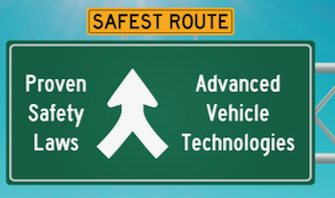Seven states received negative ratings from an annual roadway safety report due to their lax texting & laws.
The Advocates for Highway and Auto Safety study fingered Arizona, Florida, Missouri, Montana, Nebraska, Ohio and South Dakota for their lack of effective texting laws.
 Arizona, Missouri and Montana do not have universal texting & driving bans. Florida, Nebraska, Ohio and South Dakota have texting laws, but enforcement is hindered by the secondary enforcement status.
Arizona, Missouri and Montana do not have universal texting & driving bans. Florida, Nebraska, Ohio and South Dakota have texting laws, but enforcement is hindered by the secondary enforcement status.
Ohio avoided the group’s “red” for “danger” signifier by having a cell phone restriction for novice drivers. (“Thirty-one states have an optimal GDL cell phone restriction,” the group said.)
All seven states were serial offenders, with the red rating based on number of safety laws.
Receiving upgrades for distracted driving laws in the “2018 Roadmap of State Highway Safety Laws” were Texas and Iowa, which enacted text messaging laws with primary enforcement for all drivers in 2017.
The Advocates for Highway and Auto Safety study does not factor in laws addressing all drivers talking on cell phones, however. It also does not consider laws regarding Internet-related functions of smartphones, such as accessing social media sites. These are the key areas most state lawmakers are addressing in the distracted driving arena.
The National Safety Council, for instance, has called for outright bans on the use of cell phones while driving.
Many of these states with existing texting laws are in the process of updating to reflect the many distracting activities made possible by smartphones. Many distracted driving laws were enacted when texting was the primary computer-related use of cell phones.
Advocates for Highway and Auto Safety did not respond to a previous request for comment on its electronic distracted driving criteria, but noted in the 2018 report that it would be “redefining” its distracted driving reporting: “The change will reflect the growth of platforms and concern about their use for communications while driving.”
Other laws taken into consideration in the study’s grading of states include those covering seat belt and motorcycle helmet use, child passenger safety, teen drivers and alcohol impairment.
Group president Catherine Chase noted the continuing death toll on U.S. roadways as “solutions continue to languish or be ignored in state capitals, Congress and at the U.S. Department of Transportation.” The report pointed to the promise of driverless cars.
> Read the 2018 road safety report.
> Read the 2017 road safety report.


There is no evidence that strong texting laws have an effect on driver safety. A review of states with texting laws shows no difference in the accident rate before and after the law is implemented. The laws are merely a revenue stream for states and this is what they like. he politicians can tout “we are doing something about this great danger to save our children” and at the same time bring in a ton of new tax money to spend.
When will we get real about this problem and implement a failsafe technical solution that is easy to do?
The lack of evidence is due to the lack real laws, nationwide, leading to lax, or no enforcement whatsoever. For hands free to actually work, it’ll come as an app in the vehicle that blocks cell signals unless the vehicle is in “Park” … Period! End of Story. The technology has existed for many years, but legislators are too self absorbed to make real law.